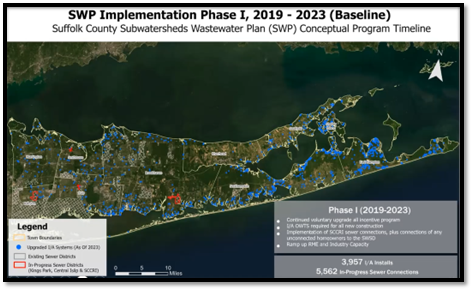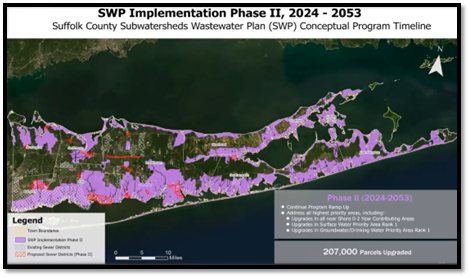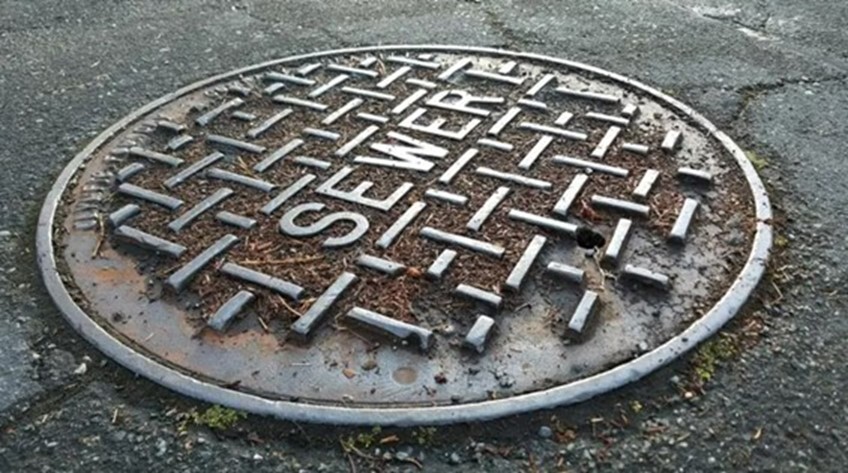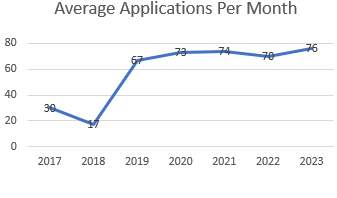Long Island Nitrogen Action Plan (LINAP)- Newsletter
The New York State Department of Environmental Conservation sent this bulletin on 12/04/2023 10:26 AM EST |
| DEC Delivers - Information to keep you connected and informed from the NYS Department of Environmental Conservation |
Long Island Nitrogen Action Plan (LINAP) - Newsletter
|
|
In Suffolk County the greatest source of nitrogen pollution is the excessive use of cesspools and septic systems. With a staggering 380,000 systems currently in operation, Suffolk County ranks among the region’s most severely affected by nitrogen pollution in the nation. Subwatersheds Wastewater Plan In 2020, the Suffolk County Subwatersheds Wastewater Plan (SWP) was approved by the County Legislature and by New York State as a Nine Element (9E) Watershed Plan. The SWP proposes the elimination of 299,000 cesspools and septic systems over 50 years through the connection of parcels to sewers or the use of Innovative and Alternative Onsite Wastewater Systems (I/A OWTS) in areas where sewers are not feasible. These systems significantly reduce nitrogen and, when properly designed, sited, installed, and maintained, provide a cost-effective and environmentally sound alternative to sewers. The SWP will be implemented in three phases. We have almost completed Phase 1, which ends this December, and is focused on voluntary upgrades to I/A OWTS by homeowners. Phase 1 is considered a success with nearly 4,000 I/A OWTS installed across the County. (Read more about the program below in the Septic Replacement Program section). Also included in Phase 1 is sewer construction, and that is also well underway. The sewering projects are being constructed and will connect thousands of parcels to sewers. (Read more about the different sewering projects that are underway in the Sewer Expansion Updates section below.) Phase 2 will begin in 2024 and aims to address all high-priority areas across the County, upgrading 35,000 parcels to sewers and 264,000 to I/A OWTS. The county is poised to make Phase 2 a success as well anticipating efforts to streamline the grant application process. Phase 3 will begin in 2054 and end in 2068. During this phase the goal is to upgrade all remaining parcels in the priority areas totaling 299,000 parcels!
SWP Implementation Phase I & II. Photo Credit: Suffolk County. Countywide Wastewater Management District The continued implementation of the SWP requires the establishment of a Countywide Wastewater Management District (CWMD) to provide the administrative structure necessary for the long-term wastewater improvements recommended in the SWP and, provide a dedicated recurring funding source for sewer infrastructure and I/A OWTS installations. The District would result in a more efficient, integrated approach to the development of new wastewater infrastructure, by consolidating the existing County sewer districts into a single zone and creating a second zone comprised of un-sewered parcels for which infrastructure improvements will involve the installation of I/A OWTS. The consolidation of the existing sewer districts would address the wide variability in sewer fees and associated costs to ratepayers that currently exists, provide for a uniform cost for delivery of sewer service and allow for the cost-effective administration of sewer system infrastructure improvements. For the District and the recurring funding source to be implemented a ballot measure is needed for voters to decide on the establishment for the District and the sales tax increase. The Suffolk County Water Quality Restoration Act, enacted as part of this year’s state budget, enables the County to move forward with a ballot measure on the creation of the District and a recurring revenue source funded by a one eighth of one percent sales tax increase estimated to generate $3.1 billion over 50 years. The Act also extends the existing one-quarter of one percent sales tax dedicated to Suffolk’s Drinking Water Protection Program to 2060. The County legislature must approve the Act in order for it to move forwards. The Legislature has voted to recess the Act and hearings will continue at the next General Meeting of the Legislature on December 5, 2023. Long Term Monitoring and Adaptive Management Plan A Long-Term Monitoring Plan (LTMP) and Adaptive Management Plan (AMP) are important initiatives recommended in the SWP. These plans will put the structure in place to track trends and recommend adjustments to the SWP, if needed. Having a LTMP and AMP in place will be critical to properly monitor the implementation of the SWP and adapt it to changing conditions over its anticipated 50-year duration. This will be pivotal in maintaining the SWP's trajectory in the face of unforeseen challenges, ensuring that the Plan remains responsive and effective amid the fluctuating dynamics of the environment and the community. A key element of the LTMP will be the cross collaboration of stakeholders that maintain active monitoring programs in the waters of Suffolk County or with programs advancing the reduction of nitrogen. The LTMP will identify, to the extent possible, the elements of existing monitoring programs that can be integrated into a unified countywide monitoring strategy, with the goal of eliminating program redundancy. The County has hired a consultant to develop the LTMP and AMP, slated to be completed next year. These plans will ensure a robust mechanism for continuous monitoring and adaptive management throughout the SWP's long trajectory. Sewage Treatment Capacity Study The Sewage Treatment Capacity Study is looking at private Sewage Treatment Plants (STP) to determine if there is capacity to connect additional parcels to sewers throughout Suffolk County. Private sewage treatment plants are often owned by private entities, including businesses, residential communities, or industries. Private STPs with additional capacity are uniquely positioned to provide both environmental protection through the connection of adjacent unsewered parcels to advanced wastewater treatment and to help facilitate targeted economic development. Identifying the STPs that have the capacity to serve additional parcels will be critical in guiding future decisions about sewer expansions in the County getting us closer to achieving the SWP’s goals for sewer connections. To date, 24 private STPs have been evaluated throughout the County.
Photo Credit: LIRPC Sewer Expansion Updates The County has made tremendous progress in the expansion of sewer systems through the Suffolk County Coastal Resiliency Initiative and with the assistance of federal, state, and town funding. The various sewering projects underway will eliminate over 7,000 cesspools and septic systems improving water quality, boosting economic development, and protecting against storm surges by strengthening wetlands. This represents the largest expansion of sewer infrastructure in Suffolk County in nearly 50 years! Construction has already begun in the Carlls River and Forge River Watersheds, utilizing cost-effective low-pressure sewer systems that minimize construction disruption. The Carlls River project is anticipated to be completed in 2024 and the Forge River project in 2026. Sewer expansion projects in the Kings Park Business district and Central Islip have also broken ground this year. The Kings Park project will connect 105 downtown business parcels and a 144-unit apartment complex to Sewer District Number 6. Construction in Central Islip will connect 64 parcels in Central Islip’s Central Business District to Sewer District Number 3. Both projects are expected to be complete in 2025.
Groundbreaking in Central Islip. Photo Credit: Suffolk County The Huntington Station Hub Sewer Project aims to connect approximately 229 parcels in the vicinity of the Huntington Railroad Station promoting economic development in downtown Huntington Station. The project is expected to begin in February 2024. In March of this year, construction was completed in the Westhampton Village Business District. Raw sewage is now transported to a treatment plant at Francis S. Gabreski Airport in Westhampton Beach and will eliminate around 5,000 pounds of nitrogen annually from entering village waterways, significantly reducing local water pollution. Septic Replacement Grant and Rebate Programs There are many areas of the county where sewers are not a cost-effective solution. In those areas, the County has been effectively pursuing the use of I/A OWTS. There are millions of them installed around the world and some of them have been in place since the 1970’s and are still functioning effectively. Under the County’s Septic Improvement Program, homeowners are eligible for a grant for the purchase and installation of an approved I/A OWTS and associated engineering and design services. Homeowners who decide to replace their cesspool or septic system with the new and advanced technologies are eligible up to $30,000 in grants from Suffolk County and the New York State Septic System Replacement Fund to offset the cost of one of the new systems. The Towns of Southampton, East Hampton and Shelter Island have followed the County’s lead and offer rebate programs for homeowners who want to upgrade, enabling some residents to qualify for up to $40,000 in total. Public interest in the program continues to remain exceptionally high with the County consistently receiving more than 70 applications per month. To date, the County has issued over 4,800 grants, underscoring the program's widespread impact and resonance within the community.
Average Septic Replacement Applications per Month in Suffolk County. Photo credit: Suffolk County Department of Health Services. The County is anticipating the streamlining the SIP application process in order to quadruple output from 500 installations per year to 2,000! The grant agreements will be simplified, electronic contracts will be available, and a centralized grant portal will be developed. Grant Opportunity – FEMA Building Resilient Infrastructure and Communities FEMA’s Building Resilient Infrastructure and Communities (BRIC) grant program will support states, local communities, tribes and territories, as they undertake hazard mitigation projects, reducing the risks they face from disasters and natural hazards. The BRIC program’s guiding principles are to support communities through capability and capacity building, encourage and enable innovation; promote partnerships, enable large projects, maintain flexibility, and provide consistency. Submission deadline: February 29, 2024. For more information on this grant opportunity, visit the program webpage here. To sign up for the LINAP newsletter, visit our webpage or click here. |





